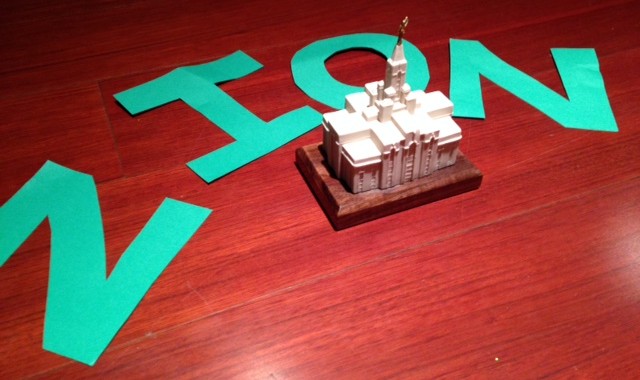I had a fun time with this lesson. I felt like I had a clear focus, which gave me a chance to really push my lesson home. I do wish I had more time to polish it, but I spent the day Monday Christmas-ing up the house for my daughter, and didn’t realize I hadn’t planned my lesson until I went to bed. I decided to read the text, and it was apparent that I had already read and marked it up the previous week, but I literally could not remember a thing about what I had planned to do. I spend the evening locating a few quotes, reading the different manual approaches, and came up with my ideas.
Then disaster struck. Technical problems GALORE. I had my tablet set up to be used as scriptures, and my cell set up with my quotes, but the screen blacked out in between my house and class. Then I couldn’t get on the open wireless in the building. I tried to use my cell phone as a hotspot, but with the screen black it was impossible. I thought my tablet would have been synced with my phone for the quotes, but somehow my D&C manuals got uninstalled on the tablet, and with no wifi, I couldn’t get to my quotes! I was dying. Even though I got there 30 minutes early, we were 7 minutes late starting. I finally did locate my quotes, and luckily I usually write my lessons longhand in a notebook, so there were no technical difficulties there.
Anyway, in the middle of all this, I rearranged the recliners (this is a theater room) to be in a circle (normally they are set in hideous rows that I hate). Teaching adults is just like teaching kids: they love variety. The smallest things can pique their interest and helps them focus their attention more easily on learning. Every student commented on the circle, and when latecomers arrived and tried to sit outside the circle, students invited them in. Being able to see everyone’s faces increased our commenting and sharing even above normal levels. I’m a big fan of circle or u-shaped seating arrangements. I may go ahead and set it up this way next week, too.
But anyway, this week, I set up in a circle to introduce D&C 57:1–3. Where is the center of our circle? Why is it important to know the center of an object? Decent discussion here. People had been reading in the BoM about a New Jerusalem on the American continent and were anxiously awaiting an announcement. It finally came in D&C 57. After reaching the scripture passage (D&C 57:1–3) aloud, we briefly discussed what Zion is (cf Moses 7:18, D&C 97:21). Zion is more than just a physical location. I read this statement from the Seminary home study manual:
The early Saints may have thought they were only to build a city, but the Lord intended to build a righteous people as well as a city. The protective “tent” of Zion can be found wherever people are obeying the laws of the celestial kingdom.
I put construction paper letters Z I O N on the floor.
Is it reasonable to expect the people to live in this way? Pure in heart? No poor? Righteousness? This has happened before. Talked briefly about the City of Enoch and Nephites at the time of Christ’s coming.
After placing a small model of a temple on top of my ZION letters, I asked, why do you think it is important to have the temple at the center of Zion? This went pretty well. I have some students who have not been to the temple yet, and a few who are long time temple workers who were able to share some thoughts. Good discussion here.
The lesson had gone pretty fast up until this point, but for the next part, we slowed down.
In addition to putting the temple at the center of our lives, how do people in a Zion society behave? We read D&C 59: 1, 3, 5, 6, 7, 8, and 9-10 while identifying Zion actions. This went great. One student had read the student manual and suggested we all do our hands like a telescope to focus and keep our eyes single.
Verse 5 is about how Zion people behave toward God.
Verse 6 talks about how Zion people behave toward each other.
Verse 7 – How does being grateful show we are a Zion people? Cf to verse 21 – How is our relationship with God damaged when we don’t show gratitude for our blessings? (Now here, I deviated from the manual a little bit. The manual implies that somehow we “hurt” God’s feelings if we don’t say we are thankful. It asks us to consider how we feel when we do something nice and they don’t say thank you. I am not sure this is a good way to think about God. I’m not sure that the way I feel is necessarily how God feels. I do think that ingratitude damages our relationship with God, but I think it’s because I’m distancing myself from God when I fail to show gratitude. He is still there, doing His thing. It’s me that’s failing to recognize where my blessings come from thereby separating myself from Him. Anyway, my opinion, and I said so in class, saying that the above “hurting God’s feelings” thing was in the manual, but that I thought that the damaging came from me turning from God, not Him turning from me.)
Verses 9-10 were on keeping the sabbath day holy. I read the Mark E Petersen quote from the student manual:
Our observance or nonobservance of the Sabbath is an unerring measure of our attitude toward the Lord personally and toward his suffering in Gethsemane, his death on the cross, and his resurrection from the dead. It is a sign of whether we are Christians in very deed, or whether our conversion is so shallow that commemoration of his atoning sacrifice means little or nothing to us” (“The Sabbath Day,” Ensign, May 1975, 49).
And I showed a video of President Monson talking about Sabbath observance to close:
Great lesson. The center place, and eye single themes worked perfectly with our circular chairs, and really pushed the idea “Where is my center?” home.


